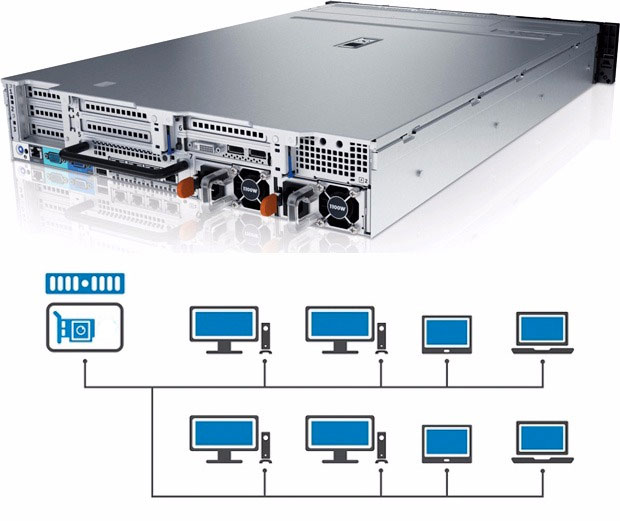Deliver Engineer Ready Desktops Remotely & Securely
August 1, 2016
 Some gauge their value to an organization by the size or location of their office. For engineers, the measuring stick has long been their workstation specs. The more bells, whistles and horsepower under their desks, the higher their rank in the pecking order. Those days are rapidly fading as engineering teams realize mobility and collaboration not only improve their productivity, but unchain them from their desks. Thin and light have become the new bragging rights, but engineers still require high-octane workstation muscle. That’s where virtual workstations come in.
Some gauge their value to an organization by the size or location of their office. For engineers, the measuring stick has long been their workstation specs. The more bells, whistles and horsepower under their desks, the higher their rank in the pecking order. Those days are rapidly fading as engineering teams realize mobility and collaboration not only improve their productivity, but unchain them from their desks. Thin and light have become the new bragging rights, but engineers still require high-octane workstation muscle. That’s where virtual workstations come in.
 The Dell Virtual Appliance for Wyse provides high-performance desktops for up to 32 users per appliance with a user experience that is indistinguishable from a physical environment.
The Dell Virtual Appliance for Wyse provides high-performance desktops for up to 32 users per appliance with a user experience that is indistinguishable from a physical environment.All the benefits of mobile computing and collaboration without their computing and security compromises are now available to engineers. Thanks to a slew of new technology advances, including virtual GPUs, compression capabilities and next-generation secure endpoints, organizations can finally tap into the benefits of virtualized environments for hardcore engineering work as an alternative or a complement to traditional workstation hardware.
Freedom and Security
Similar to other workloads migrating to a virtualized environment, virtual workstations centralize compute and graphics processing on a single platform or appliance, allowing users direct access to its resources through a thin client, entry-level laptop or even their old tower or mobile workstation.
This computing model has a number of advantages particularly well suited for engineering workflows. In a virtualized environment, engineers are no longer tethered to their desks to work with CAD and simulation models or other critical intellectual property (IP). Instead, they can tap into powerful centralized infrastructure resources and collaborate from wherever they are working as long as they have an internet connection. For engineers, the flexibility to conduct design reviews or iterate concepts from a client site or from home is a boon to work-life balance and effective communication.
Because everything in a resides in a centralized location rather than dispersed individual engineering workstations, critical IP, such as product designs, remain in sync in a virtualized environment, ensuring that all contributors have access to the most current information, regardless of where they are working. This simplifies data management and eliminates version control issues.
Along with the promise of mobility and better collaboration, enhanced security is another upside. In a virtual workstation environment, secure compressed pixels are being streamed to endpoints, which are sending back secure compressed keystrokes and mouse movements. There is no data resident on the endpoint itself, so if it is lost or stolen, valuable data is not compromised. In addition, data centralization enables organizations to establish need-based access to IP based on enterprise governance and security policies, further ensuring that critical IP is properly safeguarded.
Ready for Engineering Work
Unlike early virtualization environments that weren’t fully equipped to handle the robust graphics requirements of 3D design and engineering software, new technologies such as virtual GPUs and compression techniques now ensure that virtual workstations perform on par with their traditional, physical counterparts. In addition, the leading independent software vendors, including Autodesk, Dassault Systèmes, Siemens and PTC, have taken steps to certify and optimize their CAD and PLM software to run on virtual workstations. As a result, engineers will find it difficult to distinguish between a virtual and physical workstation environment, stamping out any lingering concerns about system degradation or a compromised user experience.
Despite these well-documented benefits, many organizations will still bump up against cultural and organizational challenges as they contemplate a move to virtual workstations. Some engineers will dig in their heels, not wanting to give up what they perceive as more control and better performance with the familiar physical workstation environment. Top level execs have to budget for an initial upfront expense even though they are clearly convinced of the ROI resulting from streamlined IT management, improved worker productivity and greater IP protection.
A smart virtualization strategy, led by the right business champions, can allay cultural concerns and conquer organizational challenges. By moving to virtual workstations, engineers get the horsepower they need to streamline complex product development and design on a global scale with all the flexibility, security and simplicity of a modern computing experience.
To help explain the benefits of virtual workstations for graphic-intensive engineering work, DE has produced “Making the Case for Virtual Workstations” with support from Dell and NVIDIA. It answers common questions about virtual workstations, exposes myths associated with them, and outlines the return on investment opportunities. You can download it for free at here.
Subscribe to our FREE magazine, FREE email newsletters or both!
About the Author
DE’s editors contribute news and new product announcements to Digital Engineering.
Press releases may be sent to them via [email protected].
Related Topics






